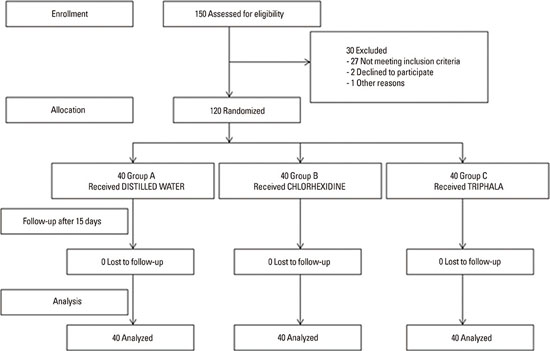1. Haffajee AD, Socransky SS. Microbial etiological agents of destructive periodontal diseases. Periodontol 2000. 1994; 5:78–111.

2. Axelsson P. In : Lang N, Karring T, editors. Mechanical plaque control. Proceedings of the 1st European workshop on periodontics, 1993; London: Quitessence;1994. p. 219–243.
3. Eley BM. Antibacterial agents in the control of supragingival plaque: a review. Br Dent J. 1999; 186:286–296.

4. Nagappan N, John J. Antimicrobial efficacy of herbal and chlorhexidine mouth rinse: a systematic review. J Dent Med Sci. 2012; 2:5–10.
5. Addy M, Moran JM. Evaluation of oral hygiene products: science is true; don't be misled by the facts. Periodontol 2000. 1997; 15:40–51.

6. Asadoorian J. Oral rinsing. Can J Dent Hyg. 2006; 40:1–13.
7. Loe H, Schiott CR. The effect of mouthrinses and topical application of chlorhexidine on the development of dental plaque and gingivitis in man. J Periodontal Res. 1970; 5:79–83.

8. Imfeld T. Chlorhexidine-containing chewing gum. Clinical documentation. Schweiz Monatsschr Zahnmed. 2006; 116:476–483.
9. Van Leeuwen MP, Slot DE, Van der. Essential oils compared to chlorhexidine with respect to plaque and parameters of gingival inflammation: a systematic review. J Periodontol. 2011; 82:174–194.

10. Rolla G, Loe H, Schiott CR. Retention of chlorhexidine in the human oral cavity. Arch Oral Biol. 1971; 16:1109–1116.

11. Adams D, Addy M. Mouthrinses. Adv Dent Res. 1994; 8:291–301.

12. Flotra L, Gjermo P, Rolla G, Waerhaug J. Side effects of chlorhexidine mouth washes. Scand J Dent Res. 1971; 79:119–125.

13. Overholser CD Jr. Longitudinal clinical studies with antimicrobial mouthrinses. J Clin Periodontol. 1988; 15:517–519.

14. Addy M. Chlorhexidine compared with other locally delivered antimicrobials: a short review. J Clin Periodontol. 1986; 13:957–964.

15. Bose S, Sinha SK, Mukherjee G. In-vitro study of triphala on antioxidant activity. Sci Cult. 2011; 77:511–513.
16. Surya Prakash DV, Sree Satya N, Avanigadda S, Vangalapati M. Pharmacological review on Terminalia chebula. Int J Res Pharm Biomed Sci. 2012; 3:679–683.
17. Dar PA, Sofi G, Parray SA, Jafri MA. Halelah siyah (Terminalia chebula retz): in unani system of medicine and modern pharmacology: a review. Int J Inst Pharm Life Sci. 2012; 2:138–149.
18. Vani T, Rajani M, Sarkar S, Shishoo CJ. Antioxidant properties of the Ayurvedic formulation Triphala and its constituents. Pharm Biol. 1997; 35:313–317.

19. Padmawar A, Bhadoriya U. Phytochemical investigation and comparative evaluation of in vitro free radical scavenging activity of Triphala & Curcumin. Asian J Pharm Med Sci. 2011; 1:9–12.
20. Ariyaphong W, Kanjana J, Seewaboon S. Triphala: The Thai traditional herbal formulation for cancer treatment. Songklanakarin J Sci Technol. 2009; 31:139–149.
21. Malhotra R, Grover V, Kapoor A, Saxena D. Comparison of the effectiveness of a commercially available herbal mouthrinse with chlorhexidine gluconate at the clinical and patient level. J Indian Soc Periodontol. 2011; 15:349–352.

22. Abraham S, Kumar MS, Sehgal PK, Nitish S, Jayakumar ND. Evaluation of the inhibitory effect of triphala on PMN-type matrix metalloproteinase (MMP-9). J Periodontol. 2005; 76:497–502.

23. Desai A, Anil M, Debnath S. A clinical trial to evaluate the effects of triphala as a mouthwash in comparison with chlorhexidine in chronic generalized periodontitis patient. Indian J Dent Adv. 2010; 2:243–247.
24. Thomas B, Shetty SY, Vasudeva A, Shetty V. Comparative evaluation of antimicrobial activity of triphala and commercially available toothpastes: an in-vitro study. Int J Public Health Dent. 2011; 2:8–12.
25. Biradar YS, Jagatap S, Khandelwal KR, Singhania SS. Exploring of antimicrobial activity of triphala Mashi-an Ayurvedic formulation. Evid Based Complement Alternat Med. 2008; 5:107–113.

26. Griffiths J, Jones V, Leeman I, Lewis D, Patel K, Wilson K. Guidelines for the development of local standards of oral health care for dependent, dysphagic, critically and terminally ill patients. Revised. [London]: British Society for Disability and Oral Health;2000.
27. Sumi Y, Nakamura Y, Nagaosa S, Michiwaki Y, Nagaya M. Attitudes to oral care among caregivers in Japanese nursing homes. Gerodontology. 2001; 18:2–6.

28. Leyes Borrajo JL, Garcia VL, Lopez CG, Rodriguez-Nunez I, Garcia FM, Gallas TM. Efficacy of chlorhexidine mouthrinses with and without alcohol: a clinical study. J Periodontol. 2002; 73:317–321.

29. Santos A. Evidence-based control of plaque and gingivitis. J Clin Periodontol. 2003; 30:Suppl 5. 13–16.

30. Gupta M. Therapeutic uses of the polyherbal drug triphala in geriatric diseases. Int J Pharm Bio Sci. 2010; 1:1–13.
31. Maurya DK, Mittal N, Sharma KR, Nath G. Role of triphala in the management of peridontal disease. Anc Sci Life. 1997; 17:120–127.
32. Bajaj N, Tandon S. The effect of triphala and chlorhexidine mouthwash on dental plaque, gingival inflammation, and microbial growth. Int J Ayurveda Res. 2011; 2:29–36.

33. Narayan A, Mendon C. Comparing the effect of different mouthrinses on de novo plaque formation. J Contemp Dent Pract. 2012; 13:460–463.

34. Jagadish L, Anand Kumar VK, Kaviyarasan V. Effect of triphala on dental bio-film. Indian J Sci Technol. 2009; 2:30–33.

35. Tandon S, Gupta K, Rao S, Malagi KJ. Effect of triphala mouthwash on the caries status. Int J Ayurveda Res. 2010; 1:93–99.

36. Axelsson P, Lindhe J. Efficacy of mouthrinses in inhibiting dental plaque and gingivitis in man. J Clin Periodontol. 1987; 14:205–212.









 PDF
PDF ePub
ePub Citation
Citation Print
Print




 XML Download
XML Download